The Jane Austen Mysteries
The Jane Austen Mysteries series by Stephanie Barron feature Jane Austen as an amateur detective, presented as entries in journals recently "discovered" in the basement of an old house previously owned by one of Jane's relatives. Some Janeites might recoil in horror at such a notion, but there are biographies of Jane Austen that have more fictional events than these books do, disguised behind the veil of scholarship. Casting Jane as a detective is inspired; the same eye for observation that makes her books such a joy to read would be invaluable to a sleuth. There are certainly enough gaps in her biographies to allow the imaginative author free rein, and Ms. Barron does a masterful job at constructing believable, enjoyable mystery stories around the real events of Jane Austen's life.
Unfortunately, there are a few cons. Ms. Barron's biographical facts are a bit off in places (one suspects that Ms. Barron depends overmuch upon the much-despised Halperin biography). It is doubtful that Mrs. Austen was as silly and Mrs. Bennet-ish as Ms. Barron has portrayed her, nor that Jane hung out with the aristocracy as much as these novels depict. The dialogue is more formal in tone than the dialogue in Jane's books, and Ms. Barron needs to go over her modes of address, both for the aristocracy and other people: for instance, Jane's father would have been referred to as the Reverend Mr. Austen, not "Reverend Austen." But after all, these are fiction, and the problems are quite minor, especially compared to some of the huge mistakes in the published sequels. In general the series is delightfully written and puts most of the sequels in the shade in terms of sheer readability.
The most enjoyable aspect of the mysteries is Jane's mini-romances and what can only be described as flirtations with various male characters. If you are frustrated by the whole Tom Lefroy/Harris Bigg-Wither/Mysterious Suitor By The Sea thing, here's your cure! Well, a partial cure, obviously, since Jane never married, so the romances don't ever seem to work out. The gentlemen always sail off to America, or skulk off to perform dangerous and dashing deeds for crown and country. It is also fun to see events that are similar to Jane's novels, as if she drew her inspiration from real-life occurrences.
Don't think Jane wouldn't have approved of these novels. She had a great sense of humour, a vivid imagination, and could be whimsical. These books are a salute to her talent and her literary legacy, and a darned good read besides.
It is probably best to read them in order of publication, as there is a continuing story arc that is in the background of the main mysteries, though each novel stands quite well on its own.
In this book we are introduced to the central conceit of the series: that a set of journals kept by Jane Austen have been lately discovered in a Maryland estate previously owned by some relative of Jane's. We are also introduced to Lord Harold Trowbridge, a "gentleman rogue" who interests--and is interested by--our Jane. Lord Harold crops up, even for a single scene, in almost all of the novels, and their friendship intensifies as the series goes on.
As the story begins, it is December, 1802, and Jane is visiting her good friend Lady Scargrave, with whom she became acquainted in Bath. Lady Scargrave's husband of three months dies mysteriously, and when Lady Scargrave is accused of murdering him, Jane sets out to find the truth.
Ms. Barron is clearly feeling her way a bit in this one, especially as compared to the later books, but the story hangs together quite well, and if you can ignore the biographical missteps and some other problems such as the proper forms of address to peers, the books is utterly un-putdownable.
It is September, 1804, and Jane, Cassandra, and their parents are on holiday in Lyme Regis, where murder and adventure find Jane once again. She becomes involved with the search for a smuggler known as "The Reverend," who is also considered responsible for two murders. Could the mysterious and very attractive Mr. Geoffrey Sidmouth be The Reverend? And could Mr. Sidmouth be the mysterious Suitor-By-The-Sea of every Jane Austen biography?
It is December, 1804, and Jane is back in Bath; she attends a masquerade, at which one of the revelers is murdered. Lord Harold's nephew is accused of the crime, and Jane helps him to find the truth while getting mixed up with portrait painters, actors, and other people that a nice parson's daughter has no business being involved with.
It is August, 1805, and Jane is visiting her brother Edward and his family at Godmersham. It is a frightening time in Kent, as Napoleon is gathering his troops along the French coast in preparation for an invasion of England. Closer to home, one of Edward's neighbours, a lady of dubious reputation who also happens to be French, is brutally murdered. Edward is the local magistrate, and Jane helps him to investigate the crime.
The Malice Domestic series features short stories by leading mystery writers. Jane and the Spoils of Stoneleigh is Stephanie Barron's contribution to the seventh anthology.
It is 1806; Jane, Cassandra, and Mrs. Austen are staying at the mansion on Stoneleigh estate, of which a cousin has taken possession to forestall challenges to an iffy will left by the previous owner, the Honourable Mary Leigh, another cousin on Jane’s mother’s side. The first order of business for the new proprietor is to find the papers of ownership for Stoneleigh; unfortunately, the Hon. Mary had a quirky sense of humour, and she hid the papers away, leaving behind literary riddles as directions to their location. Fortunately the Austens, proud novel-readers, are at hand to help find the papers—and to uncover a long-held, terrible secret.
It is August, 1806. On a visit to Derbyshire, Jane quite literally stumbles across the eviscerated corpse of what appears to be a handsome young man, but turns out to be a woman in male clothing: a woman who was the stillroom maid at a nearby estate and known as something of a local wise-woman. Jane sets out to solve the mystery of the maid's death and becomes entangled with the extremely dysfunctional Cavendish family at Chatsworth, which is in mourning for Georgiana, the Duchess of Devonshire. Lord Harold, a close friend of the Cavendishes and the late Duchess, is there as well, and Jane is conflicted about her feelings toward him--and Lord Harold's feelings about Georgiana's daughter, Harriet.
It is February, 1807, and Jane, Cassandra, and Mrs. Austen have taken a house in Southampton with Captain Francis Austen and his pregnant wife. Frank's good friend, Captain "Lucky Tom" Seagrave, is accused by his first lieutenant of murdering a French captain who had just surrendered to Seagrave. Seagrave will hang from the yardarm unless Jane can prove him innocent, with the help of a fascinating French naval surgeon.
It is October, 1808; Jane is contemplating a removal from Southampton, along with her mother, sister, and her friend Martha, to a house owned by her brother Edward in Chawton village, when Lord Harold Trowbridge summons her onboard a passing Royal Navy brig and requests her assistance. He asks Jane to keep an eye on a beautiful new neighbour, who might have ties to Napoleon, as port towns and Royal Navy ships are being burnt along the coastline.
We confess ourselves less than satisfied with this book than with the previous books in the series. We are not sure if that is because of the surprise ending (which we learnt of accidentally before reading the book, and with which we are exceedingly displeased) or because the overblown, melodramatic dialogue is more prevalent than usual. Even in 1808, people didn’t talk like that, and one cannot imagine Jane ever writing this stuff in her journal. A little more of Jane’s rapier wit and a little less Radcliffean word-paintings would improve the book immensely. (Oh, and Walter Scott did not become a baronet until a few years after Jane’s death; thus, she would not have referred to him as “Sir Walter.”) That being said, we are intrigued to see where Ms. Barron takes the series after the abrupt, shocking conclusion.
Margaret C. Sullivan is the webmistress of Tilneys and Trap-doors and always has a soft corner for a Gentleman Rogue.











Leave a comment
This site is protected by hCaptcha and the hCaptcha Privacy Policy and Terms of Service apply.